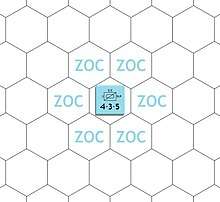Zone of control
In board wargames, a zone of control (ZOC) is the area directly adjacent to a combat unit that affects the movement and actions of enemy combat units during their turn. In hexagonal tiled maps, the six hexagons adjacent to the hexagon occupied by a unit could be considered to be in its "zone of control".[1]

Zones of control commonly are used to represent the portion of the map over which a military ground formation has a direct influence, due to the range of its weapons and the distance its sub-units may deploy from its center of gravity.[2] Game rules often include specific effects associated with a zone of control. Typical effects include one or more of the following:
- Prevent further movement, including voluntary advances or retreats.
- Enemy units must be attacked.
- Increased movement cost.
- Interdiction of enemy supply lines.
- Partly negate enemy zone of control.
- Destruction of retreating enemy units.
- Reveal hidden enemy units.
In theory, zones of control represent the military necessity of having to slow down in the presence of the enemy, such as moving off road, dismounting from transport, and moving through cover. In practice, since board wargames are played in turns alternating between the two players, zones of control are used to limit what one player's units can do during their turn while the other player's units are inactive, awaiting their turn. Without zones of control, players could use their fast-moving units to bypass and surround the other players' units without letting them getting a chance to react.
The effects of zones of control can vary significantly in different wargame rules, including some forms commonly termed "rigid", "fluid", and "locking". Rigid zones of control force enemy units to stop, fluid zone of controls (also called "elastic") slow down enemy units (increasing the movement cost of the hex), locking zones of control prevent enemy units from leaving once they enter.[1] Some types of zones of control require attacking the enemy units. Zones of control may be cancelled by terrain features such as mountains, rivers, the presence of enemy units, or even by enemy zones of control, depending on the game design. A couple of wargames even have zones of control partially affect friendly units, representing traffic congestion on nearby roads and access paths.
Strategy computer games, such as the Civilization series, commonly use zones of control as a method to balance combat and grant extra strength to units in pairs.
Notes
- "Gamespeak Glossary". Introduction to War Gaming (PDF). New York: Simulation Publications. 1977. p. 23. Archived from the original (PDF) on 2015-06-10.
- Proctor, Bob (May–June 1982). "A Beginner's Guide to Strategy and Tactics in Eastern Front". Computer Gaming World. Vol. 2 no. 3. p. 10. Retrieved 31 October 2013.